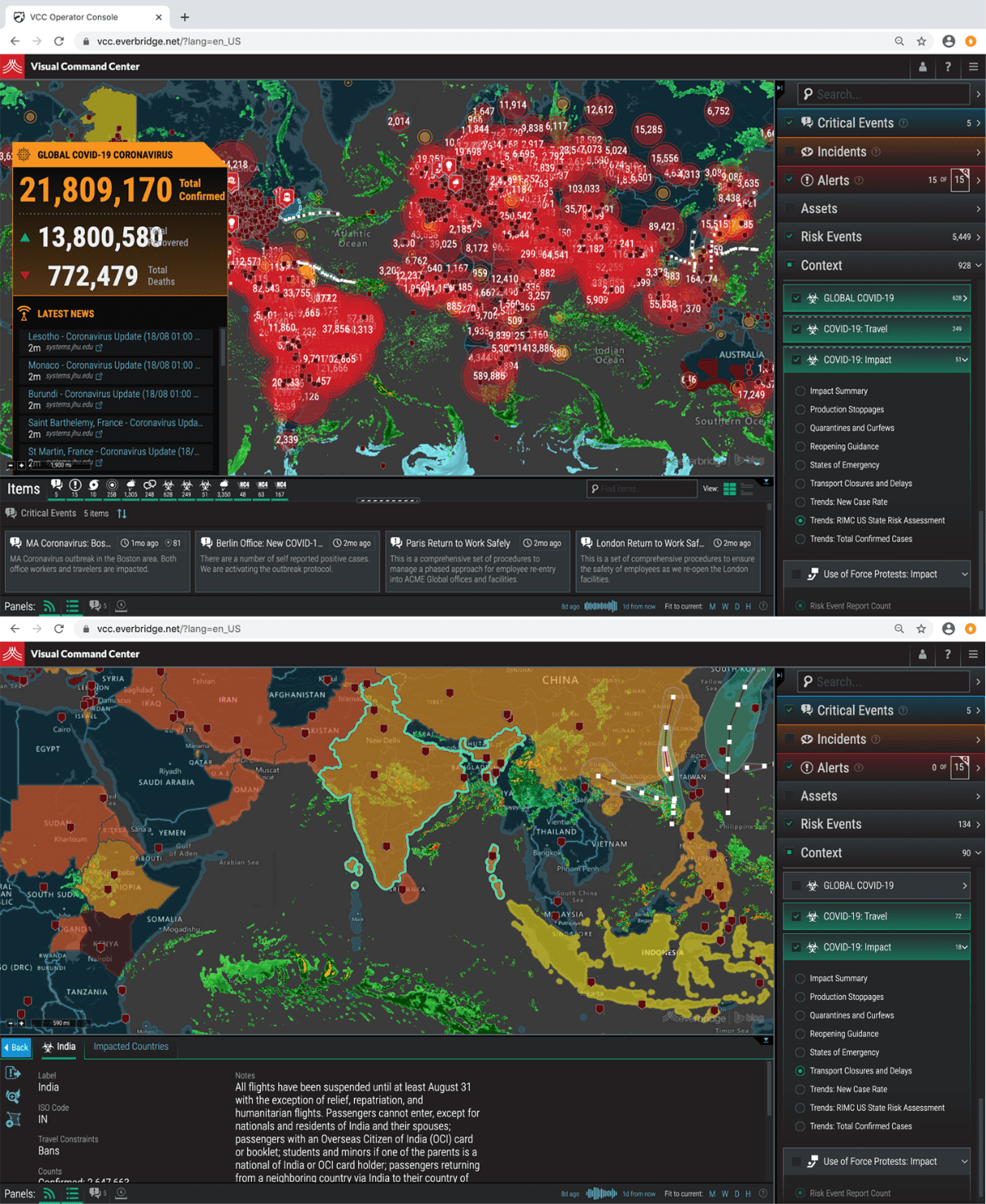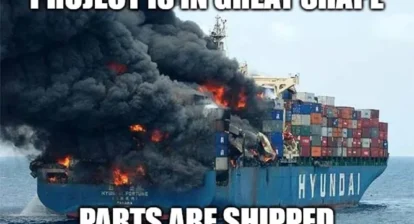
Collage by Jigs Gaton
The black swan* has landed, and is honking up a storm, as I am sure you have all noticed. In my 30+ years of planning, I’ve never seen anything like this; have you? Personally, I never paid enough heed to Disaster Planning and Risk Management until after leaving the USA and becoming a PM nomad, but once I was out in the world, it became clear that I had to do much better.
Managing projects in the Congo was my first experience with a true swan event, and it was more like a flock of them, but those honkers had AKs and RPGs and would kidnap the workers right out from under a project. Imagine planning with Boko Haram lurking in the background…we had not. We did our best to beef up security plans and deal with the resulting delays every time a band of terrorist blew something up, or worse. For most projects, we undertook massive reactionary workarounds just to move work forward, not to mention operating with a non-functioning budget and dealing with falling mortar rounds.
The outbreak of Ebola throughout the region didn’t help either, but Nigeria was surprisingly well prepared, as they have seen the worst the world has to offer. They have also managed to systemize measures that mitigate many dilatory effects of ongoing and compound disasters, while still moving forward on a timeline. It’s amazing, pure brute-force project management! If you throw lots of money and people on a problem, sometimes it works. Shout out to Nigeria.gov.ng and to all the great folks working a myriad of UN acronyms (UNHCR, UNDP, UNOPS, UNICEF, UNESCO, UNECA, etc., etc.).
These examples; however, are not what we have going on today. With the spread of the Covid-19 virus world-over and compounding critical events being spewed out like the virus itself, we see a scenario like none other. Most swans of the familiar variety fly local: tsunamis, earthquakes, landslides, civil wars, economic and political instabilities, etc. When I look back at typical responses to these more common swans, I mostly see patched-up project plans, ones that are duct-taped together, after the fact!
Here is what is so baffling especially now: all non-US contracts I’ve ever signed include a boiler-plate Force majeure clause, but those are clicked through faster than the legalese on a social media app, and this class of risk is rarely reflected in any of the planning exercises that these contracts pertain to. I have to ask “Why not?”
If contingency plans and risk matrixes exist (in Africa, they mostly did not), the overall impact of measures taken during a swan event is mostly minimal, and at best, marginally effective. In my experience, most baby swan scenarios go something like this: before anyone can dig out a risk spreadsheet to find out what to do, knee-jerk tasks are added to plans and acted upon. The adrenaline rush is too great; calmer minds hardly ever prevail when the amygdala becomes your project manager. At this point, we seem to throw systematic approaches out the window, or can’t figure out where we filed them. The non-technical term is running around like chickens with our heads cut off. Could it be that human nature is now making many smaller projects fail, and letting larger ones go astronomically over budget? Is rampant counterfactual thinking ruining our efforts today? (Please chime in below!)
Before we condemn stupidity (or counterfactual thinking), let’s step back and assess… are the tried and true PMI (or other board certified) methodologies and PM strategies working well for you during this age of Covid? I contend maybe not, and this series of articles (plus a webinar) will discuss why, and what can be done during the current crisis to prepare for the next. We might not be as stupid as they say…
Let’s Tally Up the Response So Far…
In preparation for us to all go twitching for the elusive honking swan, please take a few moments to complete this anonymous survey. This will set the baseline for the following discussion, and the results will be published in the second part of this article, as well as becoming useful talking points for an upcoming MPUG webinar.
Create your own user feedback survey
With That Groundwork Dug, Let’s Discuss the Birds and the Bees…
As mentioned in a previous article, the way we have handled project management since the days of Henry Ford and Mr. Gantt has got to change, if not by PMs, then by the natural course of disastrous events destined ahead. Ask yourself, for the events on the horizon, will your organization have control over the outcome, or will the next event overcome you? The good news is that as we move into the 4th Wave Of Industrial Development, AI will be doing more and more heavy-lifting for PMs. So, it’s worth diving into how the silicon brains will try to save us from honking black swans, and flying through other mitigations that might be useful in the days ahead.
Note: There is some debate over whether the Covid-19 Pandemic is a “black” or “white” swan event. I choose to ignore such back and forth, but those interested psych majors who love dwelling on the problem of Induction in Logic, may want to check out Taleb. In my experience, swan events tend to molt into multiple shades of catastrophe, logarithmically complicating our planning efforts over time.
There are numerous warning signs that may or may not go unheeded before a swan defecates on well-laid plans. Events like this leave us to sift through a ton of guano, just to find footing again. Wouldn’t it be nice if there were clear warning signs and less guano? Well, here are a few:
Warning signs that a black swan is about to poop over your project plans:
![]()
Warning Sign #1: We Purport to Know What We Don’t Know. In 2018, the Business Continuity Institute’s Horizon Scan Report listed the five biggest threats for business in the US were: 1. Cyber-attack, 2. Data breach, 3. Unplanned IT & telecom outages, 4. Interruption to utility supply, and 5. Adverse weather.
I guess they missed Bill Gate’s Ted Talk in 2015, “Not Missiles, but Microbes.” Perhaps every PM should have Gate’s quote printed on a T-shirt or coffee mug. Either way, it’d be smart to think of it as a metaphor for interacting with their project plans every day. We used to say things like, “Be calm, carry on” or “It’s the little things that get you.” Apparently, they do—repeatedly.
In the above mentioned case, we were all looking for really spectacular things to worry about, like masked villains holding our computers for ransom or an infrastructure unprotected from aliens, instead of considering simpler things that could’ve gone wrong, like hey, what if everyone came down with the flu at the same time, and then they all called in sick– from everywhere!
![]() Warning Sign #2: Small Disasters Wreak Havoc Even on a Good Day. If your organization or team is frequently struggling with unforeseen, but knowable problems, that’s a sign that your Risk Mitigation planning is not where it should be. If you have no such plan (even without the daily disasters), you are pretty much sunk already, no? Maybe not, but more on that later…
Warning Sign #2: Small Disasters Wreak Havoc Even on a Good Day. If your organization or team is frequently struggling with unforeseen, but knowable problems, that’s a sign that your Risk Mitigation planning is not where it should be. If you have no such plan (even without the daily disasters), you are pretty much sunk already, no? Maybe not, but more on that later…
![]() Warning Sign #3: PMs are Complacent During the Good Times, and “It Is what It is” when Not. Sure, your plans are rolling along just fine, stocks are up, airfare low, everything is on schedule, and the market caps are looking pretty darn good—then bam, welcome to 2020. The bird is in da house. What next, is it business as usual, or is it time to do things differently?
Warning Sign #3: PMs are Complacent During the Good Times, and “It Is what It is” when Not. Sure, your plans are rolling along just fine, stocks are up, airfare low, everything is on schedule, and the market caps are looking pretty darn good—then bam, welcome to 2020. The bird is in da house. What next, is it business as usual, or is it time to do things differently?
Moving Forward, During, and After This Bird Attack…
With many of us still working at home (I am), now is a great time to consider a relatively new field of study for managers: Critical Event Management (CEM), which promises to provide a holistic approach to dealing with wild swans, and enables a more unified, efficient, distributed, automated, and collaborative process to follow. In other words, it’s better than most of us do today. By way of example, let’s consider this matrix for a minute or two:

From 9 Steps to CEM Improvement, Imad Mouline, CTO of Everbridge, who develops AI that sorts this all out for us.
Now riddle me this: does your current Risk Management Plan or PM software help solve this puzzle, on a case-by-case basis, depending on the nature of the critical event and the circumstances surrounding said event? I don’t think any of the plans or tools I’ve reviewed do. So, how do we address this? Use AI, of course!
The trend in 2020 is to develop AI for puzzles like this—the ones that make our heads hurt and keep us up at night. Complex matrixes with dependencies that stretch out like jellyfish tentacles tend to overwhelm us, especially when we are in a state of crisis. So, let’s work smart and have a silicon brain fry over puzzles like this, instead of our own.
That’s what the folks at Everbridge are planning for us to do. That is, to use AI to grapple with critical events like the ones surrounding us now. I spoke with Claudia Dent, Senior VP of Product Marketing @ Everbridge, and here is how she sees it:
Q. What does a project manager need to know during times like these?
A. Any project manager needs to know their risk landscape, and the pandemic brings a whole different dimension to that landscape. Not only is it about an impending hurricane or cyclone, but it is also about all the potential impacts and disruptions that result from COVID-19 – production stoppages, quarantines, the ability to return to work.

Everbridge’s AI-powered Dashboard for CEM: Allows you to drill down into multilayered-layered crises around the globe – or in your hometown – you choose! Mix and match your disaster, and even import MSP tasks for correlation.
Q. What are some specific examples of this way of CEM thinking?
A. If you have manufacturing or a construction project underway, for example, [you must ask] what will the impact of the pandemic be to that project? What if there is an outbreak on your project site? Do you understand local protocols for handling such an event? [What about} privacy policies? How will quarantined resources impact your timelines? A project manager needs to foresee and understand all the impacts to business initiatives on a global basis.
Q. But how, specifically, does a PM do that – it’s not in the manual…
A. This is insight that you cannot always access easily. Understanding your risk landscape requires a common operating environment, bringing external risks (Pandemic, weather, civil unrest, etc. …) with your own internal threats (security, IT system failure, industrial accidents, etc. …) to see the total impact. The only way to achieve this is through automation. You need risk intelligence, correlation, and response orchestration that enable you to fully assess and put those pieces together for a faster resolution.
For more from Claudia and more on how Everbridge helps leverage AI, read Part 2 of this article. I also plan to include the collective results of the survey. If you have comments so far, please share them below, and watch the on-demand MPUG webinar. Safe planning!
*A black swan is a metaphor that describes an event that comes as a surprise, has a major effect, and is often inappropriately rationalized after the fact with the benefit of hindsight. The term is based on an ancient saying that presumed black swans do not exist – until you see one! The theory of black swan events was developed by Nassim Nicholas Taleb [more…]






